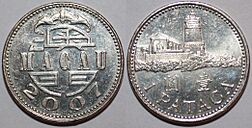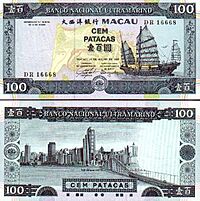Macanese pataca facts for kids
Quick facts for kids Macanese pataca |
|||
|---|---|---|---|
| 澳門元 (Chinese) Pataca de Macau (Portuguese) |
|||
|
|||
| ISO 4217 Code | MOP | ||
| User(s) | |||
| Inflation | 0.37% | ||
| Source | Direcção dos Serviços de Estatística e Censos, February 2017 | ||
| Pegged with | Hong Kong dollar (HK$) HK$1 = MOP 1.03 |
||
| Subunit | |||
| 1⁄10 | 毫 (Chinese) (ho) There is no corresponding Portuguese term for ten avos. |
||
| 1⁄100 | 仙 (Chinese) (sin)
avo (Portuguese) |
||
| Symbol | $, MOP$ or 元 | ||
| Plural | patacas (Portuguese only) | ||
| Coins | |||
| Freq. used | 10, 50 avos, $1, $5 | ||
| Rarely used | 20 avos, $2, $10 (still minted) | ||
| Banknotes | |||
| Freq. used | $10, $20, $50, $100, $500 | ||
| Rarely used | $1,000 | ||
| Printer | Issuing banks:
Banco Nacional Ultramarino |
||
| Macanese pataca | |||||||||||||||
|---|---|---|---|---|---|---|---|---|---|---|---|---|---|---|---|
| Chinese name | |||||||||||||||
| Traditional Chinese | 澳門元 | ||||||||||||||
| Simplified Chinese | 澳门元 | ||||||||||||||
|
|||||||||||||||
| Portuguese name | |||||||||||||||
| Portuguese | Pataca de Macau | ||||||||||||||
The Macanese pataca (also called the Macau pataca) is the official money used in Macau. Its symbol is $ and its short code is MOP. The pataca is divided into 100 smaller parts called avos. In Cantonese, 10 avos are known as ho.
Macau uses a special system where the pataca's value is fully backed by other money, mainly the Hong Kong dollar. This means that for every pataca in Macau, there's enough Hong Kong dollars saved to cover its value. The Monetary Authority of Macau (AMCM) makes sure that you can always exchange patacas for Hong Kong dollars at a set rate: HK$1 equals MOP 1.03. This helps keep the pataca's value stable.
Contents
History of the Pataca
Early Money in Macau
For a long time, people in Macau used silver coins from Spain and Mexico. These coins were called patacas. They were brought to Asia through trade routes from the 16th to the 20th centuries. Other silver coins from places like Hong Kong and Straits Settlements were also used.
Introducing the Pataca Currency
In 1894, the pataca became an official way to count money in Portuguese Macau. It was worth the same as the Mexican Peso or Philippine Peso. Then, in 1901, Macau decided to create its own unique money. The Banco Nacional Ultramarino bank was given the special job of printing pataca banknotes.
On January 27, 1906, the first pataca banknotes were released. They came in values of 1, 5, 50, and 100 patacas. All other foreign coins were made illegal. The goal was to make the pataca paper notes the only official money. However, many Chinese people were used to using silver coins. They didn't trust the new paper money as much. So, the paper pataca was often worth a bit less than silver coins.
Changes in Value
In 1935, Hong Kong and China stopped using silver to back their money. The Hong Kong dollar was then linked to the British Pound sterling. At this time, the Macau pataca was linked to the Portuguese escudo. This meant the Macau pataca became worth less than the Hong Kong dollar.
The first coins made just for Macau were introduced in 1952. Before that, coins from other places like Canton Province were used.
Who Issues the Pataca Now?
In 1980, the Macau government created the Issuing Institute of Macau (IEM). This group was given the sole right to issue pataca banknotes. The Banco Nacional Ultramarino continued to print the notes for them.
Later, in 1995, the Macau branch of the Bank of China also started printing pataca banknotes. So, now two banks print the money. The power to issue patacas was then given to the Monetary Authority of Macau.
Coins of Macau
The first coins made for Macau came out in 1952. These included bronze 5 and 10 avos, cupro-nickel 50 avos, and silver 1 and 5 patacas. Over the years, the metals used for coins changed. For example, nickel replaced silver for the 1 pataca coin in 1968.
In the 1980s, new coins were introduced, including brass 10, 20, and 50 avos, and cupro-nickel 1 and 5 patacas. Some coins, like the 20 avos and 5 patacas, later changed shape to have 12 sides. A two-metal 10 patacas coin was introduced in 1997, and a cupronickel 2 patacas coin in 1998. The Monetary Authority of Macau is in charge of issuing these coins.
Coins You Can Use Today
Here are the coins that are currently used in Macau:
| Image | Value | Description | First Minted Year | |||
|---|---|---|---|---|---|---|
| Obverse | Reverse | Composition | Obverse | Reverse | ||
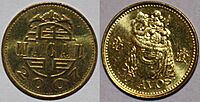 |
10 avos | Brass | "Macau", "澳門" | Value, Lion Dance Costume Head | 1993 | |
| (missing photo) | (missing photo) | 20 avos | Denomination, Dragon boat | |||
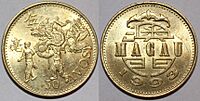 |
50 avos | Denomination, Dragon dance | ||||
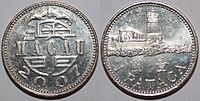 |
$1 | Cupronickel | Value, Guia Lighthouse | 1992 | ||
| (missing photo) | (missing photo) | $2 | Denomination, Templo de A-Má and Penha church | 1998 | ||
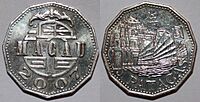 |
$5 | Denomination, Cathedral of Saint Paul, Chinese junk | 1992 | |||
| (missing photo) | (missing photo) | $10 | Ring: Brass Center: Cupronickel |
Value, St. Dominic's Church of Macau | 1997 | |
Banknotes of Macau
Macau's banknotes are printed by two different banks: the Banco Nacional Ultramarino (BNU) and the Bank of China. This is similar to how banknotes are issued in Hong Kong. Because Macau used to be a Portuguese colony, the banknotes have both Portuguese and Chinese writing on them.
After the first pataca banknotes came out in 1906, more values were added, including 10 and 25 pataca notes. Smaller notes, like 5, 10, and 50 avo notes, were added in 1920. In 1944, 500 pataca notes were introduced. The 25 pataca note was stopped after 1958.
On August 8, 1988, BNU issued a 1000 pataca banknote. This was the highest value note at the time. The date 8/8/88 was chosen because the number 8 sounds like "getting rich" in Chinese. This made the note special. Also, the Portuguese coat of arms was replaced with the BNU's logo, showing a change as Macau prepared to return to China.
In 1995, the Bank of China started issuing its own notes. These included 10, 50, 100, 500, and 1000 patacas. Both banks also introduced 20 pataca notes in 1996.
Current Banknotes
Today, banknotes are available in values of 10, 20, 50, 100, 500, and 1,000 patacas. The BNU issued its latest series of notes in 2005. The Bank of China's notes were last updated between 1995 and 2003. All Macau banknotes are the same size as Hong Kong banknotes of the same value.
On December 20, 1999, the day Macau was returned to China, new banknotes from both banks were issued with that date. In 2009, the Bank of China released a new series of notes dated 2008. In 2024, both banks plan to release even newer notes with better security features. These new notes will also have features to help people with visual impairments.
| Banco Nacional Ultramarino 2005 Series Banknote | ||||||||
|---|---|---|---|---|---|---|---|---|
| Image | Value | Description | Printed Date | Watermark | ||||
| Obverse | Reverse | Dimensions | Color | Obverse | Reverse | |||
| [1] | [2] | $10 | 138 × 69 mm | Red | Statue of Mazu | BNU building | 8 August 2005 8 August 2010 11 November 2013 6 November 2017 |
Lotus |
| [3] | [4] | $20 | 143 × 71.5 mm | Violet | Macau International Airport | |||
| [5] | [6] | $50 | 148 x 74 mm | Brown | Sai Van Bridge | 8 August 2009 11 November 2013 6 November 2017 |
||
| [7] | [8] | $100 | 153 × 76.5 mm | Blue | Largo do Senado (Senate Square) | 8 August 2005 8 August 2010 11 November 2013 6 November 2017 |
||
| [9] | [10] | $500 | 158 × 79 mm | Green | Macau Tower | |||
| [11] | [12] | $1,000 | 163 × 81.5 mm | Orange | Macau Cultural Centre | |||
| Bank of China 2008 Series Banknote | ||||||||
|---|---|---|---|---|---|---|---|---|
| Image | Value | Description | Printed Date | Watermark | ||||
| Obverse | Reverse | Dimensions | Color | Obverse | Reverse | |||
| [13] | [14] | $10 | 138 × 69 mm | Red | A-Ma Temple | Bank of China, Macau branch | 8 August 2008 1 July 2013 6 November 2017 |
Lotus |
| [15] | [16] | $20 | 143 × 71.5 mm | Violet | Façade of the ruins of Saint Paul's Cathedral | |||
| [17] | [18] | $50 | 148 × 74 mm | Brown | Dom Pedro V Theatre | |||
| [19] | [20] | $100 | 153 × 76.5 mm | Blue | Guia Lighthouse and Monte fort | |||
| [21] | [22] | $500 | 158 × 79 mm | Green | Casa do Mandarim (House of the Mandarin) | |||
| [23] | [24] | $1,000 | 163 × 81.5 mm | Orange | Legislative Senate | |||
| Bank of China 2020 Series Banknote | ||||||||
|---|---|---|---|---|---|---|---|---|
| Value | Description | Printed Date | Watermark | |||||
| Dimensions | Color | Obverse | Reverse | |||||
| $10 | 138 × 69 mm | Red brown, dark orange | the building of Bank of China in Macau, Southern Lion | Macau Tower observation lounge | 18 May 2020 | Lotus | ||
| $20 | 143 × 71.5 mm | Bluish violet | Macau Science Center Exhibition Center and the Planetarium | |||||
| Banco Nacional Ultramarino 2020 Series Banknote | ||||||||
|---|---|---|---|---|---|---|---|---|
| Value | Description | Printed Date | Watermark | |||||
| Dimensions | Color | Obverse | Reverse | |||||
| $10 | 138 × 69 mm | Red | BNU Building | Map of Macau in 1635 | 18 May 2020 | Lotus | ||
| $20 | 143 × 71.5 mm | Violet | Map of Macau in 1780 | |||||
| $50 | 148 × 74 mm | Brown | Map of Macau in 1889 | |||||
| $100 | 153 × 76.5 mm | Blue | Map of Macau in 1949 | |||||
| $500 | 158 × 79 mm | Green | Map of Macau in 1986 | |||||
| $1,000 | 163 × 81.5 mm | Orange | Map of Macau in 2022 | |||||
Special Commemorative Banknotes
Sometimes, special banknotes are made to celebrate important events.
- In 2008, the Bank of China in Macau issued four million 20 pataca notes to celebrate the 2008 Summer Olympics in Beijing.
- In 2012, both the BNU and Bank of China issued ten million 10 pataca notes for the Year of the Dragon. They are also allowed to issue special 10 pataca notes for each Lunar New Year until 2023.
- The Bank of China also made a 100 pataca banknote to celebrate its 100th birthday.
- To mark 20 years since Macau was returned to China, both banks issued five million 20 pataca notes. These notes show a golden lotus flower, which stands for Macau's success. The back of the notes features the Hong Kong-Zhuhai Bridge.
How the Pataca is Used and Exchanged
Even though the pataca is Macau's official money, the Hong Kong dollar is very commonly used there. In fact, most of the money circulating in Macau is Hong Kong dollars. Patacas made up only about 30% of Macau's money supply in 1998.
The pataca's value is fixed to the Hong Kong dollar. About MOP 1.03 equals HK$1. Hong Kong dollar banknotes and coins are usually accepted in Macau at a 1:1 rate for everyday shopping. The Hong Kong dollar is also loosely linked to the United States dollar, so about MOP 8 equals 1 US dollar.
You can easily exchange money in Macau at hotels, banks, and currency exchange places. There are even 24-hour exchange booths at the Macau International Airport and the Lisboa Hotel. However, it can be hard or impossible to exchange patacas outside of Macau.
Even though a rule says businesses must accept patacas, some casinos prefer Hong Kong dollars for bets. Both Hong Kong dollars and Chinese yuan are generally accepted in Macau, from casinos to restaurants. You can also pay government agencies with both Hong Kong dollars and patacas.
See also
- Economy of Macau
- Portuguese Timorese pataca


